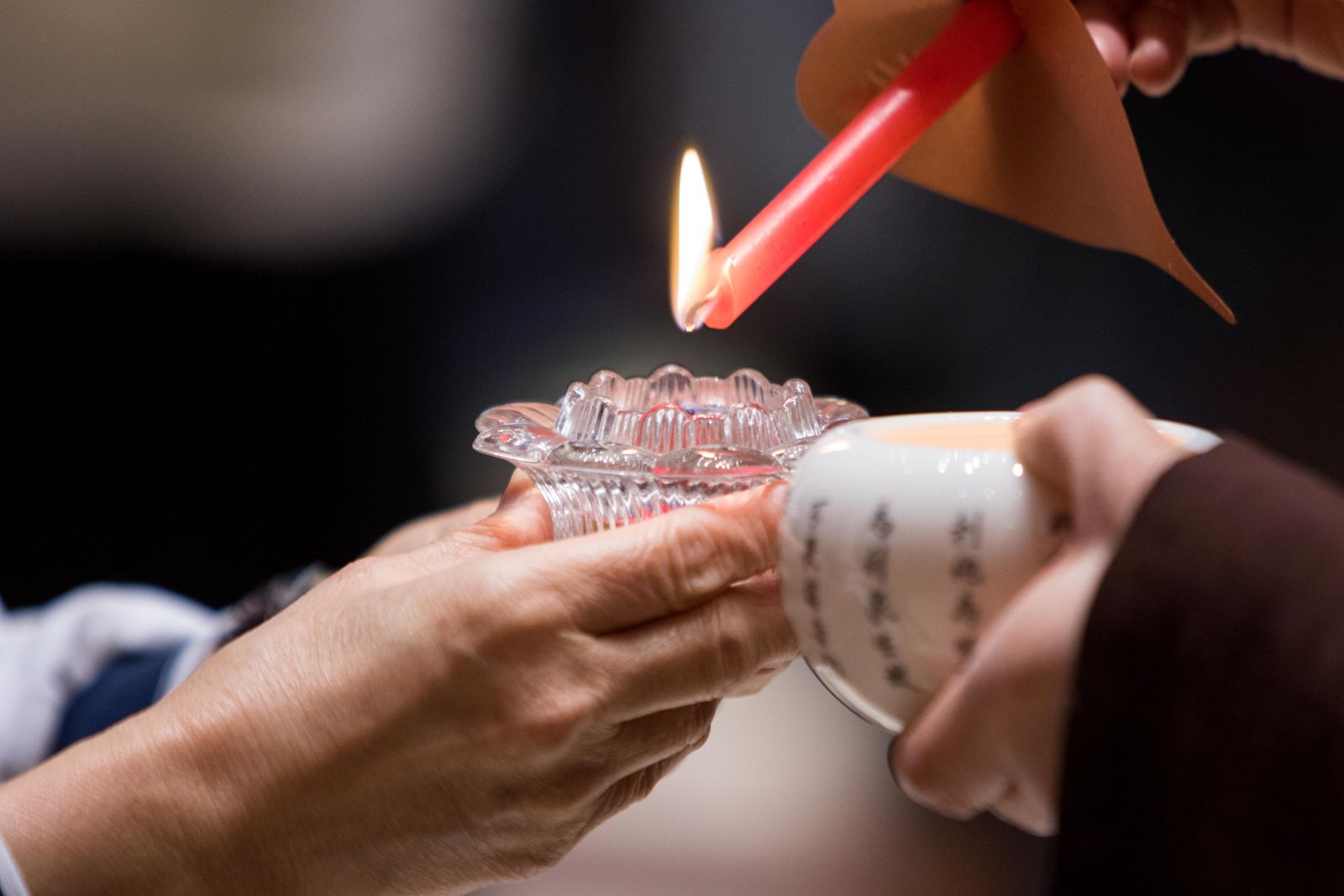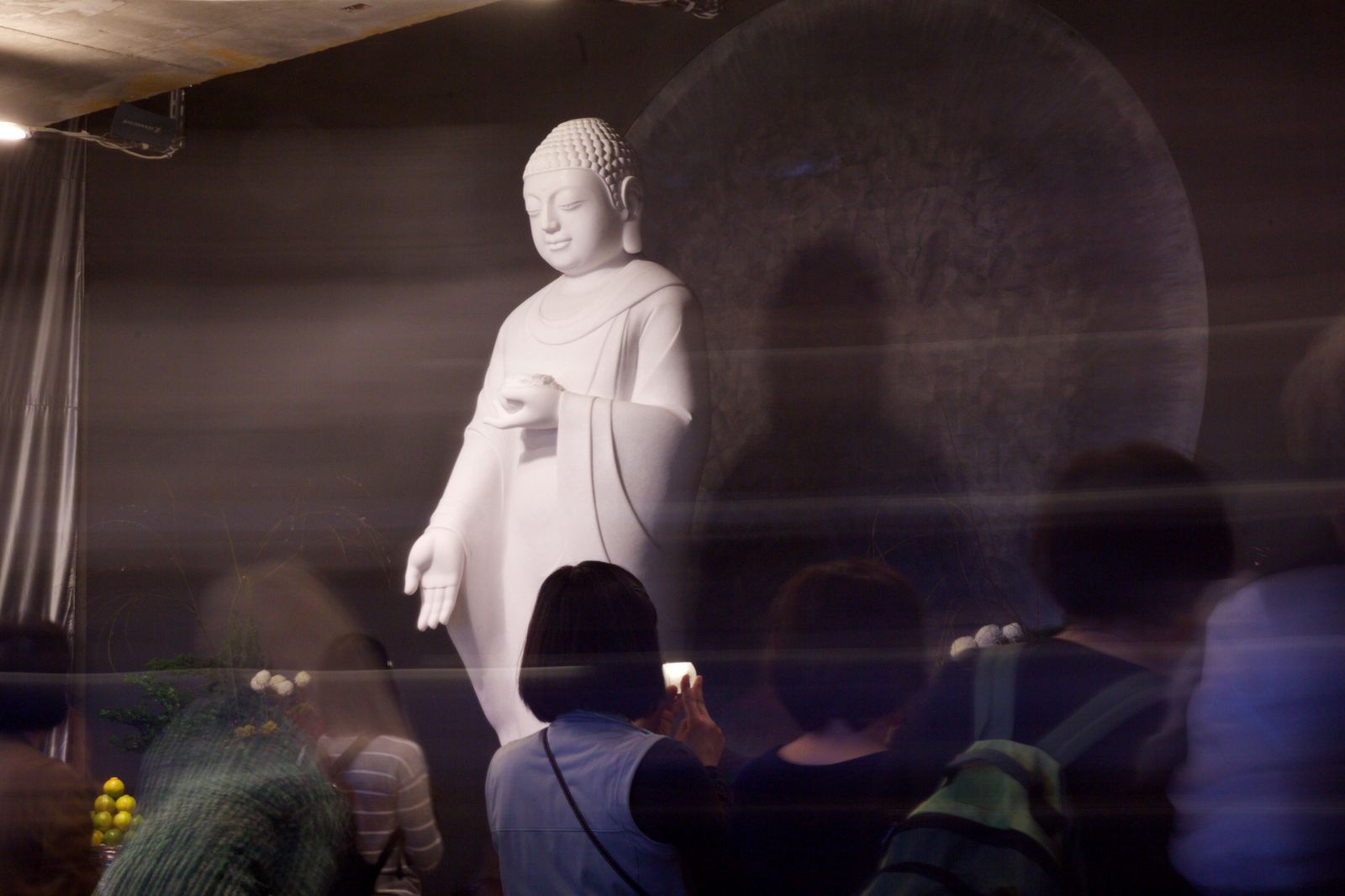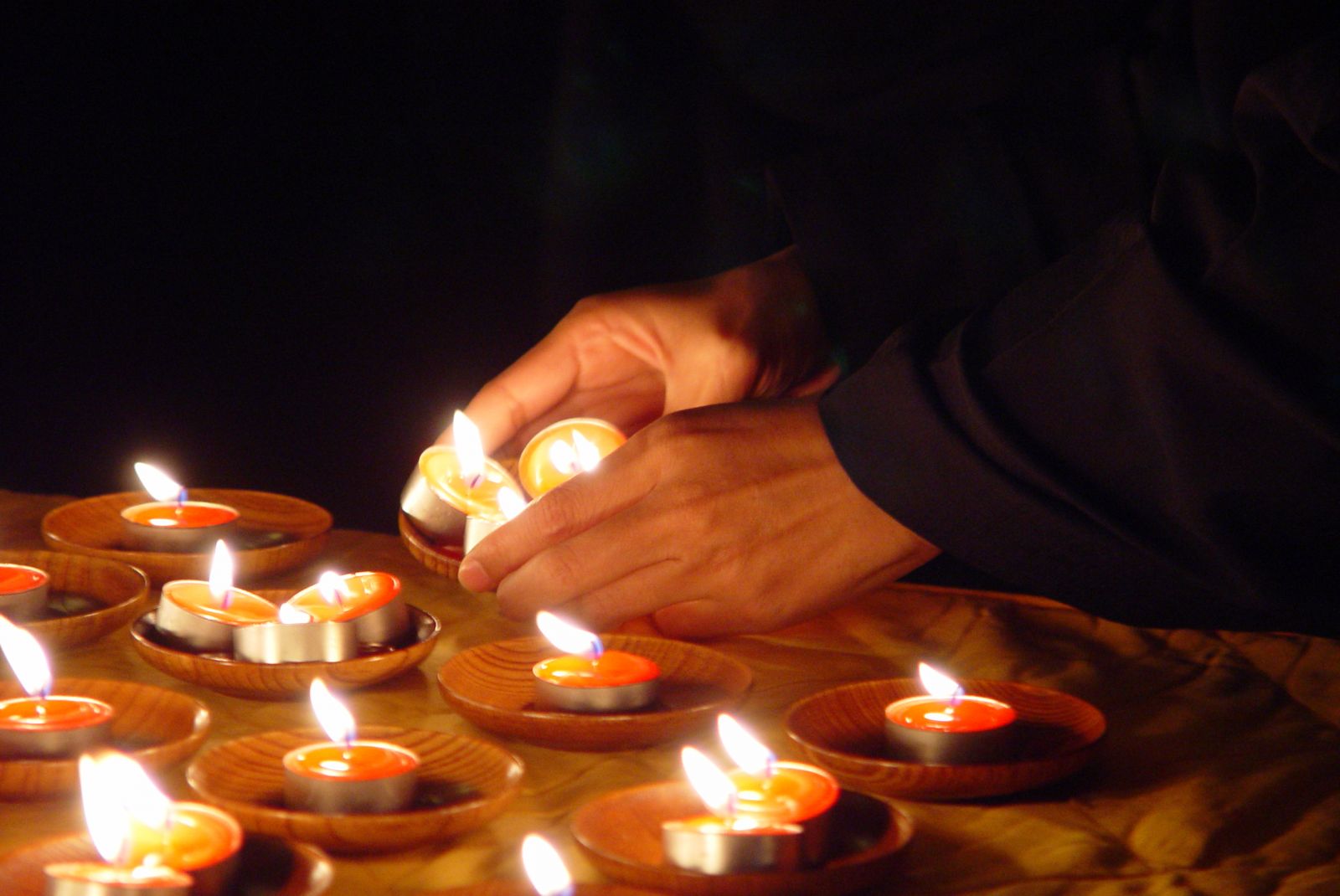Special Topics
The Origin and Transformation of Lamp Offerings
At the end of a year, people often exchange New Year wishes with their family members and friends through cards, phone calls, and messages. During this period, Buddhists take the opportunity to visit temples to make lamp offerings, hoping that, through the merit of offering lamps and the power of Buddhas' and Bodhisattvas' blessings, the New Year wishes they made will come true. At the end of each year, in major cities like Taipei, Hong Kong, New York, Frankfurt, and Paris, the streets are adorned with a sea of decorative lamps. A magnificent Tree Lighting Ceremony will be held specially for Christmas Eve. Similarly, during the Lunar New Year, Chinese communities will hold the impressive Lighting Ceremony at the Lantern Festival. The lighting of the lamp not only brightens up the night sky, but also sweeps away the dust accumulated in our mind over the past year.The origin of lamp offering comes from the need of lighting
 As a new year begins, people take the opportunity to make new wishes. Regardless of how the past year has been, people are ready to embrace the upcoming year. For Chinese communities, it is common to visit temples during this time to light lamps for themselves or their family members, as well as make wishes in their mind or express them in written form. Through lighting lamps, they wish for a peaceful and smooth year, their family's well-being, and the fulfillment of aspirations.
As a new year begins, people take the opportunity to make new wishes. Regardless of how the past year has been, people are ready to embrace the upcoming year. For Chinese communities, it is common to visit temples during this time to light lamps for themselves or their family members, as well as make wishes in their mind or express them in written form. Through lighting lamps, they wish for a peaceful and smooth year, their family's well-being, and the fulfillment of aspirations.Regardless of the underlying motives (religious or otherwise), lighting a lamp or candle as a religious ritual or festive activity makes people feel hopeful and provides them with a sense of a bright future ahead. In fact, the history of lamp-lighting can be traced back to its original purpose, which is for illumination. Due to various historic developments and the influence of religions, cultures, and customs, the meaning of lighting lamps gradually changed from the simple lighting function to symbolizing brightness, hope, prayers, and blessings. To this day, lamps are indispensable appliances in our daily lives. On the other hand, making lamp offerings as a religious ritual enhances people's faith. In early Zoroastrianism — also known as a fire-worshiping religion — fire was highly revered because it symbolizes light and hope. Chinese people have the tradition of making lamp offerings at temples and during Lunar New Year to pray for peace, good fortune, and the fulfillment of wishes. The practice of lighting up butter lamps has long been a part of daily lives of Tibetan Buddhists. In similar fashion, Catholics have the custom of lighting up candles on church candle holders. Using the candlelight, they pray or reflect in front of religious icons. The famous Notre-Dame de Paris keeps candles burning throughout the year.
Transformation of the meaning of lamp offering
The ritual of lamp offering has long existed in the history of Buddhism. It owes its origin to the beautiful story of the "Poor Woman Making Lamp Offering." According to this story, there was once a poor woman named Nanda who, seeing others lighting lamps to offer to the Buddha, aspired to make offerings as well. She used the money she begged for to buy butter and made a lamp offering. When all other lamps had burned out, hers was the only one that still shone. This story shows that the merit of lamp offerings is not determined by the number of lamps or the amount of money donated. In Nanda's act of making lamp offering, what was most valuable was the mind of offering that asked for nothing in return.
 The Pradīpadānīya Sūtra (Sutra of the Merit of Offering Light) says: "One who makes the lamp offering accumulates immeasurable and boundless blessings." In addition, the sutra introduces four merits of lamp offering, including having dignified appearance, abundant wealth and resources, great good roots (kuśala-mūla), and great wisdom, among other visible and invisible benefits. Therefore, the religious ritual of lamp offering has been passed down for thousands of years, and has stood the test of changing times.
The Pradīpadānīya Sūtra (Sutra of the Merit of Offering Light) says: "One who makes the lamp offering accumulates immeasurable and boundless blessings." In addition, the sutra introduces four merits of lamp offering, including having dignified appearance, abundant wealth and resources, great good roots (kuśala-mūla), and great wisdom, among other visible and invisible benefits. Therefore, the religious ritual of lamp offering has been passed down for thousands of years, and has stood the test of changing times.Originally, Buddhists did not have the custom of lamp offering at specific festivals. However, as Buddhism spread to different regions, different forms and occasions for making lamp offerings emerged. In Chinese Buddhism, the practice is mainly performed during the Lunar New Year, thus marking the beginning of a year. In addition to providing services for followers to offer candle or butter lamps, Chinese and Tibetan Buddhist temples may also hold Dharma services for lamp offerings, to help devotees fulfill their wishes both through their own faith and the empowerment of Buddhas and Bodhisattvas. The donation made for lamp offerings also serve to support the operation of monasteries.
As people step into temples to make lamp offerings they have already planted the seeds of wholesome thoughts within themselves. While we offer blessings to others in front of the Buddha, making the lamp offering also reminds us to fulfill our vows and be diligent in our spiritual cultivation. Moreover, as the giving of wealth, the monetary donation made for the lamp offering facilitates the temples to propagate the Dharma, thereby allowing more people to benefit from the Buddha's teaching. Thus, during Tibetan New Year, the Dalai Lama leads followers to perform lamp offerings, as well as make wishes for all beings to leave suffering behind them and attain happiness, in addition to spread world peace.
Those lacking in religious faith or firmly believing only in science may wonder: "Does making lamp offerings really serve any purpose? Can it really ward off calamities?" "Can the merit gained from the lamp offering offset one's past wrongdoings?" And "What do people make lamp offerings for?"
Ven. Guo Jian from Dharma Drum Mountain maintains: "The act of making the offering generates the mental power corresponding to the wish, and that power will have influence on one's personal behavior, thereby culminating in the wish fulfillment." In fact, the true essence of lamp offering lies in lighting a lamp as an offering to Buddhas and Bodhisattvas, for our innermost wish be supported by the Buddha. The light signifies the dispelling of our ignorance, as a reminder for us to constantly reflect on ourselves, thereby generating the motivation to act. .
Master Sheng Yen said, "Lamps bring light and brightness, as a form of heat energy. We use its light and brightness to convey, deliver our aspiration, with its heat energy signifying the function and capacity generated by our mind of aspiration. With sincerity and faith, this lamp will be effective." As Master Sheng Yen illustrated, the significance of lamp offering lies in our mind. By lightening the physical lamp with good intentions, we are lighting up the invisible lamp within our mind.
 To illuminate the lamp in our mind is to light up an everlasting lamp, as the Inexhaustible Lamp. The chapter entitled The Reluctance of the Bodhisattvas of the Vimalakīrti Nirdeśa Sūtra states: "There is a door of the Dharma called the 'Inexhaustible Lamp'. Practice it. A single lamp may light hundreds and thousands of lamps without itself being diminished. Similarly, a single bodhisattva may establish many hundreds of thousands of living beings in enlightenment without his mindfulness being diminished. In fact, not only does it not diminish, but it also grows stronger. Likewise, the more you teach and demonstrate virtuous qualities to others, the more you grow with respect to these virtuous qualities. This is the door of the Dharma called 'The Inexhaustible Lamp'." Although the Inexhaustible Lamp refers to a Buddhist approach to practice, it is also the kind of wisdom we can apply in our daily lives.
To illuminate the lamp in our mind is to light up an everlasting lamp, as the Inexhaustible Lamp. The chapter entitled The Reluctance of the Bodhisattvas of the Vimalakīrti Nirdeśa Sūtra states: "There is a door of the Dharma called the 'Inexhaustible Lamp'. Practice it. A single lamp may light hundreds and thousands of lamps without itself being diminished. Similarly, a single bodhisattva may establish many hundreds of thousands of living beings in enlightenment without his mindfulness being diminished. In fact, not only does it not diminish, but it also grows stronger. Likewise, the more you teach and demonstrate virtuous qualities to others, the more you grow with respect to these virtuous qualities. This is the door of the Dharma called 'The Inexhaustible Lamp'." Although the Inexhaustible Lamp refers to a Buddhist approach to practice, it is also the kind of wisdom we can apply in our daily lives.For example, Thích Nhất Hạnh was a practitioner who lit up innumerable Inexhaustible Lamps. He dedicated his life to the pursuit of world peace. Furthermore, like a candle consuming itself to light others, he used the brilliance of his life to ignite the lamp of mind in others. The late Mother Teresa devoted all her life to the poor in India because she maintained the spirit of candlelight that, even with its own tiny flame, aspires to ignite the wick of devotion in the minds of more people.
"When someone has the light of wisdom and compassion in their mind, they should share the illumination they possess with everyone; this can be regarded as propagating Buddhadharma." Master Sheng Yen also maintained that the inexhaustible lamp implies lighting up the lamps of wisdom and compassion in everyone, thereby enabling love to spread as well as reducing interpersonal disputes and global turmoil, in order for the world to enjoy mutual respect and happiness.
Related articles:
The Origin and Transformation of Lamp Offerings
The Diverse Forms of Lamp offerings
The Design of Lamp Offerings at Dharma Drum Mountain
Similarities and Differences in Light Offering in Different Countries
Perspectives on Lamp Lighting Across Different Cultures
Commonly Asked Questions on Light Offering
Resource: Issue 281 of Humanity Magazine, Dharma Drum Publishing Corporation
Translation: Sinag-ling Li (李祥苓)
Editing: Keith Brown, Chia-Cheng Chang (張家誠)
